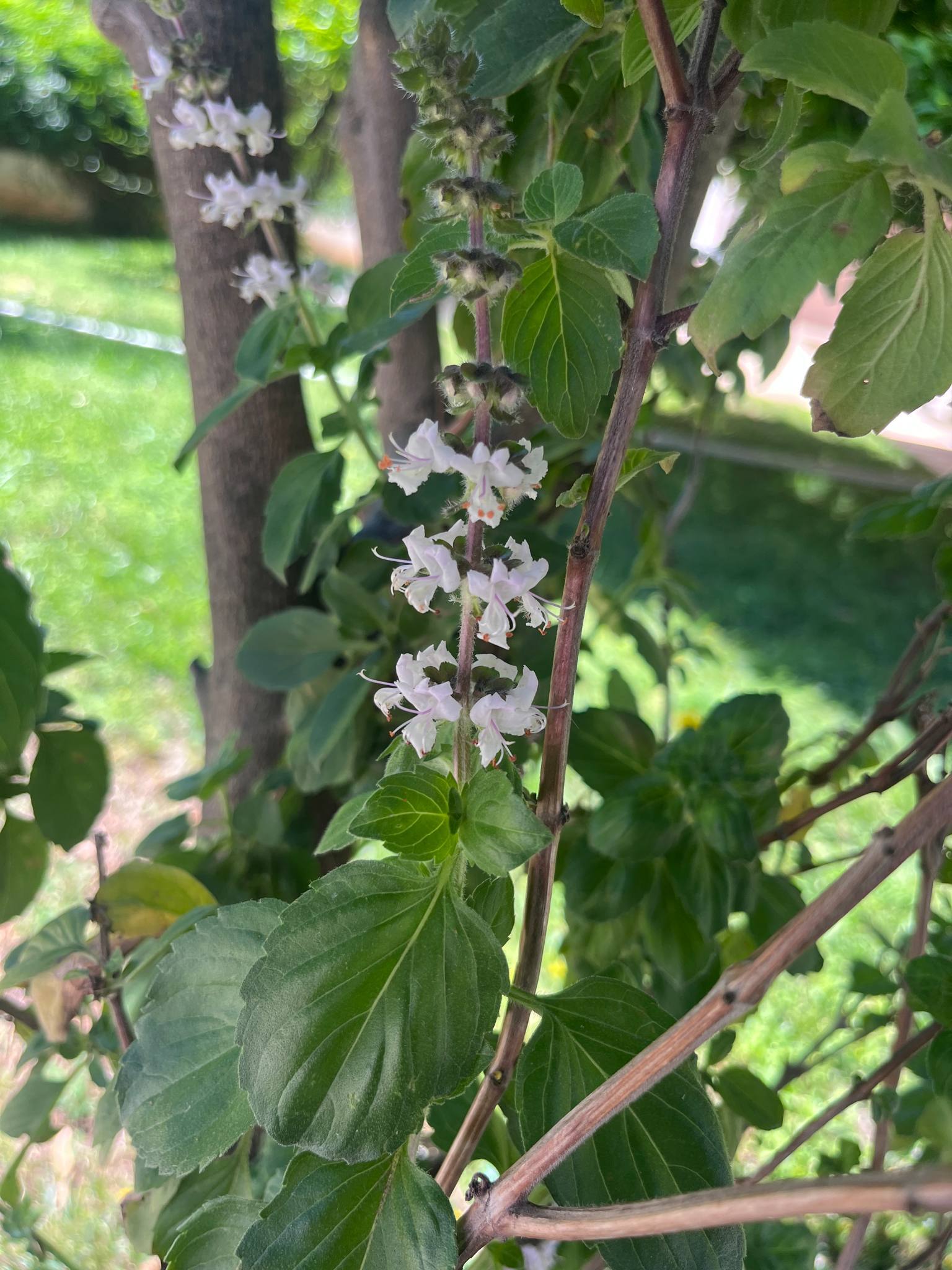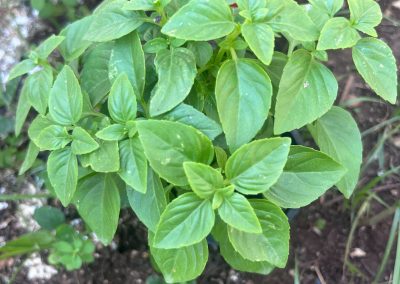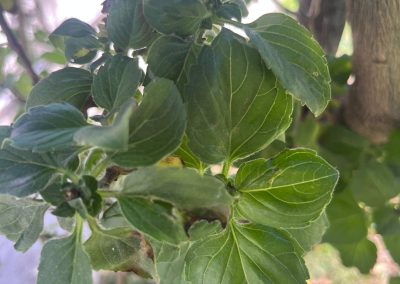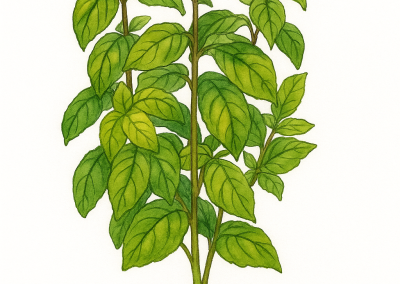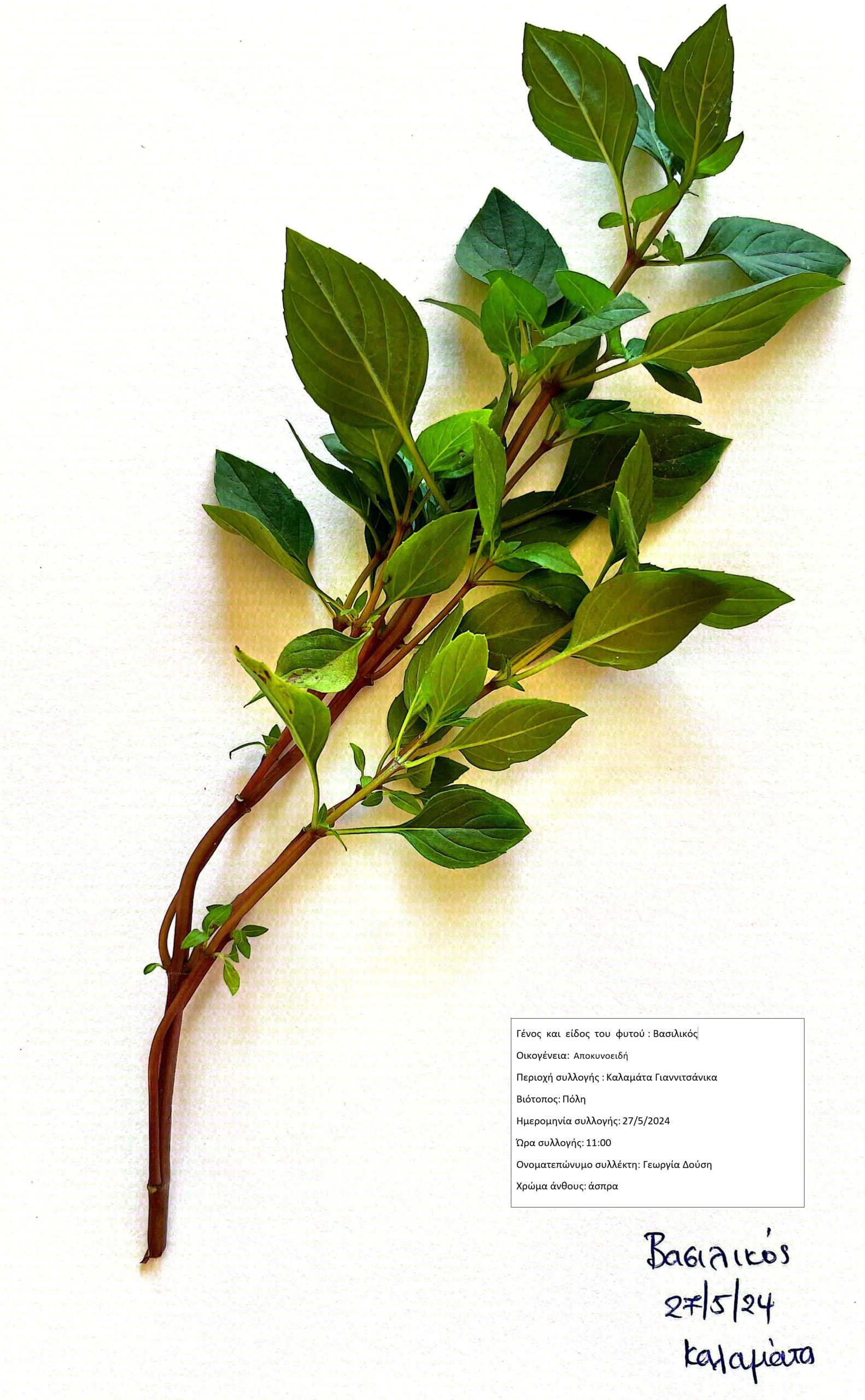Ocimum basilicum
Scientific description
Scientific name: Ocimum basilicum
Common Greek name: basilikos (“royal”)
Kingdom: Plantae
Syntax: Angiosperms
Order: Eudicots, Lamiales
Clade: Asteridae
Family: Labiatae / Lamiaceae
Genus: Ocimum
Species: Ocimum basilicum
Etymology:
“Basilikos” derives from Greek “βασιλεύς” (king), referring to Jesus Christ, linked to the Exaltation of the Holy Cross. Legend says the plant grew at the lost tomb of Jesus, its strong smell leading to the discovery of the Holy Cross by Constantine and St. Helena.
Origin:
Probably India or Iran, cultivated for over 5,000 years. Mentioned by Greek writers Theophrastus and Dioscorides. Semi-hardy annual, culinary herb, important in Italian and Southeast Asian cuisines.
Description:
Annual aromatic herb, 30-130 cm, opposite pale green silky leaves 3–11 cm long, 1–6 cm wide. Small white flowers in terminal spike. Four stamens and pistil lie above lower lip. After pollination, corolla detaches and four round achenes develop inside bilabiate calyx.
Ecology:
Very sensitive to cold. Best in warm, dry conditions. Behaves as annual if frost risk. Can be sown under glass in cold regions and transplanted in late spring. Can grow outdoors or indoors on equatorial window sill.
Propagation:
Easily propagated by cuttings.
Use:
Fresh in cooking: roasts, salads, stews, soups, sauces (pesto). Seeds become gelatinous in water, used in Asian drinks and desserts. Folk medicine: diuretic, soothes stomach ache, headache, insect/scorpion/snake bites.
Επιστημονική ονομασία: Ocimum basilicum (Ώκιμον το βασιλικόν)
Κοινό Ελληνικό όνομα: βασιλικός
Βασίλειο: Φυτά (Plantae)
Συνομοταξία: Αγγειόσπερμα (Angiosperms)
Ομοταξία: Δικοτυλήδονα (Eudicots)
Υφομοταξία: Αστερίδες (Asteridae)
Τάξη: Λαμιώδη (Lamiales)
Οικογένεια: Χειλανθή / Λαμιίδες (Labiatae / Lamiaceae)
Γένος: Ώκιμον (Ocimum)
Είδος: Ocimum basilicum
Ετυμολογία:
Η λέξη «βασιλικός» προέρχεται από «βασιλεύς» = βασιλιάς, αναφέρεται στον Ιησού Χριστό, συνδεδεμένο με την Ύψωση του Τιμίου Σταυρού. Ο θρύλος λέει ότι το φυτό φύτρωσε στο χαμένο τάφο του Ιησού, και η έντονη μυρωδιά του οδήγησε στην ανακάλυψη του Τιμίου Σταυρού από τον Κωνσταντίνο και την Αγία Ελένη.
Καταγωγή:
Πιθανόν Ινδία ή Ιράν, καλλιεργείται πάνω από 5.000 χρόνια. Αναφέρεται από Θεόφραστο και Διοσκουρίδη. Ημι-σκληραγωγημένο ετήσιο μαγειρικό βότανο, σημαντικό στην Ιταλική και Νοτιοανατολική Ασιατική κουζίνα.
Περιγραφή:
Ετήσιο αρωματικό φυτό, 30-130 εκ., φύλλα αντικριστά, ανοιχτό πράσινα, μεταξένια 3–11 εκ. μήκος, 1–6 εκ. πλάτος. Άνθη μικρά, λευκά σε τερματική ακίδα. Τέσσερις στήμονες και ύπερος πάνω από κατώτερο χείλος. Μετά την επικονίαση, η στεφάνη αποκολλάται, τέσσερα αχαίνια αναπτύσσονται στο διπλόχειλο κάλυκα.
Οικολογία:
Πολύ ευαίσθητος στο κρύο. Αναπτύσσεται καλύτερα σε θερμές, ξηρές συνθήκες. Ετήσιος αν υπάρχει παγετός. Μπορεί να σπαρθεί κάτω από γυαλί σε ψυχρές περιοχές, μεταφύτευση αργά την άνοιξη. Καλλιεργείται και σε εσωτερικό χώρο σε παράθυρο με νότιο προσανατολισμό.
Πολλαπλασιασμός:
Εύκολη η πολλαπλασίαση με μοσχεύματα.
Χρήση:
Φρέσκος στη μαγειρική: ψητά, σαλάτες, βραστά, σούπες, σάλτσες (πέστο). Σπόροι γίνονται ζελατινώδεις σε νερό για Ασιατικά ποτά και επιδόρπια. Λαϊκή φαρμακευτική: διουρητικό, καταπραΰνει στομαχόπονο, πονοκέφαλο, δαγκώματα εντόμων/σκορπιών/φιδιών.
Nom scientifique: Ocimum basilicum
Nom grec commun: basilikos (“royal”)
Règne: Plantae
Clade: Angiospermes, Astéridées
Ordre: Eudicotylédones, Lamiales
Famille: Lamiacées (Labiées)
Genre: Ocimum
Espèce: Ocimum basilicum
Étymologie:
« Basilikos » vient de « βασιλεύς » (roi), ici en référence au Christ. Associé à l’Exaltation de la Sainte Croix. Selon la légende, le basilic aurait poussé sur le tombeau perdu de Jésus et son parfum intense a permis de localiser la Sainte Croix.
Origine:
Probablement Inde ou Iran, cultivé depuis plus de 5 000 ans. Mentionné par Théophraste et Dioscoride. Plante annuelle semi-rustique, herbe culinaire importante en cuisine italienne et en Asie du Sud-Est.
Description:
Plante herbacée annuelle aromatique, 30-130 cm. Feuilles opposées, vert pâle, soyeuses, 3–11 cm long, 1–6 cm large. Fleurs petites, blanches en épi terminal. Quatre étamines et pistil au-dessus de la lèvre inférieure. Après pollinisation, corolle se détache, quatre akènes ronds se développent dans le calice bilabié.
Écologie:
Très sensible au froid, préfère chaleur et sécheresse. Comportement annuel si gel. Semis sous abri dans régions froides, puis repiquage au printemps. Peut pousser en extérieur ou en pot sur rebord orienté équatorial.
Propagation:
Facilement par bouturage.
Utilisation:
Frais en cuisine: rôtis, salades, ragoûts, soupes, sauces (pesto). Graines gélatineuses en eau pour boissons et desserts asiatiques. Médecine populaire: diurétique, calme maux de ventre, maux de tête, piqûres d’insectes/scorpions/serpents.
Denumire științifică: Ocimum basilicum
Denumire greacă comună: basilikos (“regal”)
Regn: Plantae
Sintaxă: Angiosperme, Asteridae
Ordin: Eudicotiledone, Lamiales
Familie: Labiatae / Lamiaceae
Gen: Ocimum
Specie: Ocimum basilicum
Etimologie:
„Basilikos” derivă din grecescul „βασιλεύς” = rege, aici referindu-se la Iisus Hristos. Asociat cu Înălțarea Sfintei Cruci. Legenda spune că planta a crescut la mormântul pierdut al lui Iisus, mirosul său conducând la descoperirea Sfintei Cruci de către Constantin și Sf. Elena.
Origine:
Probabil India sau Iran, cultivat peste 5.000 de ani. Menționat de Teofrast și Dioscoride. Plantă anuală semi-rezistentă, folosită în bucătăria italiană și asiatică.
Descriere:
Plantă erbacee anuală aromată, 30-130 cm. Frunze opuse, verde pal, mătăsoase, 3–11 cm lungime, 1–6 cm lățime. Florile albe, mici, în spic terminal. Patru stamine și pistil deasupra buzei inferioare. După polenizare, corola se desprinde, dezvoltând patru achene rotunde în caliciul bilabiat.
Ecologie:
Sensibil la frig, crește cel mai bine în condiții calde și uscate. Comportament anual dacă există risc de îngheț. Se seamănă sub sticlă în regiuni reci, apoi se replantează primăvara. Poate crește în aer liber sau în ghiveci pe pervaz orientat ecuatorial.
Înmulțire:
Ușor prin butași.
Utilizare:
Proaspăt în bucătărie: fripturi, salate, tocănițe, supe, sosuri (pesto). Semințele devin gelatinoase în apă pentru băuturi și deserturi asiatice. Medicină populară: diuretic, calmează dureri de stomac, dureri de cap, mușcături de insecte/scorpioni/șerpi.
Creative writing inspired by Ocimum basilicum
Ocimum basilicum
Once, in the ancient times of Greece, there lived a humble young man named Ocimus. He was known for his kindness and devotion to the gods, particularly to the goddess Demeter, the goddess of agriculture and fertility. Though poor, he was hardworking, and every day he offered the best of his herbs to Demeter's temple as a sign of gratitude.
One day, while working in the fields, he encountered a mysterious figure — a beautiful woman who asked him for some water. Without hesitation, Ocimus offered her what he had. The woman, moved by his generosity, revealed herself to be the goddess Demeter in disguise. To thank him for his faithfulness and kindness, she gifted him a rare plant, telling him that it would bring prosperity and fertility to whoever cultivated it.
This plant, with its fragrant leaves, grew quickly and became known throughout Greece for its healing and spiritual properties. People believed that it bore the blessing of Demeter, and that anyone who cared for it with respect would find happiness and fertility in their life.
The plant was named "Ocimum" in honor of the young man who first received it. Later, it became known as "basil," because it was considered the most noble and sacred of all herbs — worthy to be grown in the gardens of kings and placed in temples to honor the gods.
Thus, basil became a symbol of royal blessing and protection, and to this day it is considered a charm of prosperity and love, connected to the divine grace of Demeter and the humility of Ocimus.


